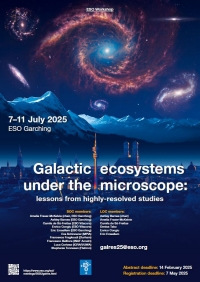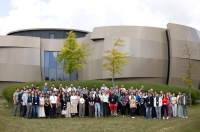
7 - 11 JULY 2025
GARCHING NEAR MUNICH, GERMANY
The intricate physics governing galaxy evolution, from inflows and outflows to star formation-driven turbulence and stellar feedback, operate on small scales, often just a few parsec. For years, such detailed resolution was achievable only for the Milky Way and its immediate satellites. However, recent advancements driven by major investments for ESO facilities, including ALMA and the VLT, along with synergetic instruments such as the HST, JWST, SITELLE, VLA, and MeerKAT, have triggered a scientific revolution. These tools now enable us to target galaxies across the local Universe and delve into the core units driving their evolution: molecular clouds, HII regions, and star clusters. Concurrently, simulations have evolved significantly, producing high-resolution models that complement these detailed observations. As a result, we are approaching the capability to analyze nearby galaxies with the same depth and precision as the Milky Way, invigorating local extragalactic science in time for the ELT era.
In response to these exciting advancements, we are pleased to announce a workshop dedicated to exploring the latest developments in resolved galaxy properties and evolution. This workshop will bring together leading experts to discuss recent scientific findings and prepare for future breakthroughs in the field. The workshop will focus on three key questions that currently drive research in galaxy evolution:
1. How do galaxies assemble their baryonic components?
Spatially-resolved observations have made it possible to distinguish the assembly history of individual galaxy components. By studying the relative contributions of various processes, such as in-situ versus ex-situ formation, we can uncover the imprints left on a galaxy’s structural components and piece together its life story. Advancing our understanding of these pathways will provide deeper insights into the baryon cycle and the connections between a galaxy’s individual components.
2. What mechanisms regulate star formation and feedback in nearby galaxies?
The delicate balance between star formation and feedback processes is a fundamental cycle that has seen considerable focus in recent years. With spatially resolved multi-wavelength observations of nearby galaxies, we can explore the intricate interplay of these mechanisms at local scales. This includes understanding why star formation occurs at specific sites, how the properties of these star-forming regions vary across the galaxy, and the impact of ionizing radiation on surrounding gas and dust.
3. How does small-scale physics connect to global galaxy properties?
While galaxies are governed by processes that occur locally on scales of tens to hundreds of parsecs, the connection between these small-scale processes and global galaxy properties remains unclear. Given that most archival galaxy observations in the local Universe (and beyond) are unresolved, understanding how small-scale phenomena map to integrated quantities is crucial. This knowledge will bridge the gap between our extensive existing data and new observations from next-generation instruments and facilities.
We invite you to join us for this exciting workshop at the ESO Headquarters in Garching near Munich, with remote participation available via MS Teams.
E-mail: GALRES25@eso.org


